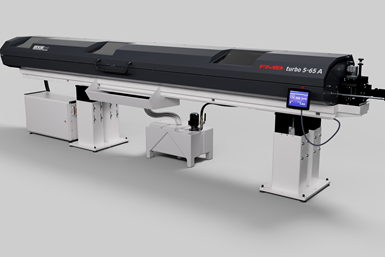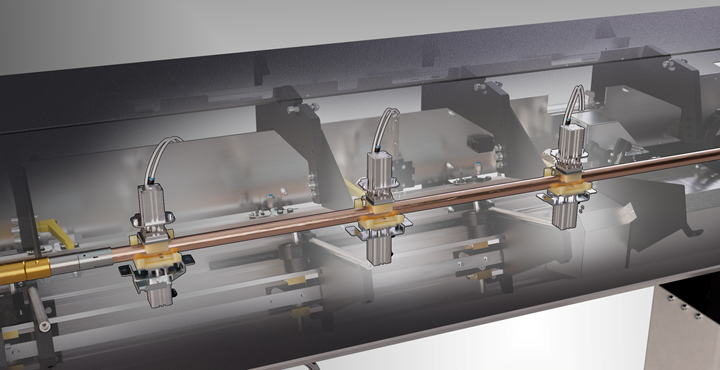
The FMB Turbo 5-56 was one of the first bar feeders to come with the Auto Adjust feature. (Photo credit: Edge Technologies)
Traditional magazine bar feeders use guide channel sets. These are a set of polyurethane blocks, top and bottom, that, when they are assembled into the channel, support the pusher and rotating bar stock as it is fed into the lathe. These channel sets are available with different inside diameters, each covering a range of bar stock diameters. For most production work, they are cost-effective and proven, especially given their quick-change features.
However, what if your shop’s application calls for more flexibility and a leaner setup? What if your goal is a fast, made-to-order capability or a family of parts of varying diameters? Auto Adjust magazine bar feeders, such as the FMB Turbo 5-65 Auto available from Edge Technologies, optimize CNC turning centers on short-run work with frequent changeovers over a wide diameter range. Shops can achieve a “lean” setup with this technology by shrinking changeover time from one hour down to five minutes.
Featured Content
Auto Adjust magazine bar feeders match the maximum-sized bar pusher to the CNC lathe’s draw tube or the maximum-diameter stock that is planned to run on the machine. The bar feeder does the rest with a series of aperture-like geared mechanisms that automatically adjust to and support the rotating stock. Change two parameters in the controller, change the bar pusher collet, and you are ready to run. You won’t have to change the spindle liner, and you will have the flexibility to run bars from 3 to 12 feet in length.
“Breaking a setup” for an emergency job can be a thing of the past when you can run multiple setups daily without having to worry about changing over the guide channel set. Auto Adjust feeders are productive and easy to operate, and lend themselves to fixed-headstock lathes with diameter capabilities ranging to 60 mm or more.

Auto Adjust magazine bar feeders match the maximum-sized bar pusher to the CNC lathe’s draw tube or the maximum-diameter stock that is planned to run on the machine. This makes them well suited for short-run work with frequent changeovers over a wide diameter range
Here are six instances in which this technology can save shops time:
Production runs are small but many. We’ve seen many shops across all sorts of industries, from robotics to architecture to spaceflight, scrambling to meet customer needs around small, just-in-time quantities with tight deadlines (think lot sizes of approximately 300 pieces). For a high-mix/low-volume shop to fulfill 400 of those orders in a day, Auto Adjust can quickly earn its keep.
Hot jobs are coming in a little “hotter” than normal. Hot jobs are profitable and important when it comes to maintaining customer relationships. Auto Adjust can help if you want to be the shop that’s easy to work with and known for being clutch on just-in-time manufacturing jobs.
There is a shortage of employees to change guide channel sets. Pre-pandemic, more people used to work in machine shops. Since 2020, establishing efficient shopfloor processes has become even more important because of less personnel. The new standard is that a lathe should run unattended. Auto Adjust offers that capability as well as added flexibility. Rather than needing an extra operator to spend an hour changing the guide channel, or, worse, pulling away a programmer from programming, you can change it adjusting two parameters.
Engineering needs to switch on a dime from one job to another. Sometimes, one moment’s top priority becomes another. This is especially true for shops that produce parts made to order, in which the next machine run is contingent on the latest order. Having the Auto Adjust costs you only five minutes, rather than an hour.
High turnover on the shop floor is an issue. Shops can experience high turnover. Changing over differently sized guide channels can be frustrating if you’re constantly having to teach new employees changeover techniques. Auto Adjust is intuitive and smooths the process.
Changeovers take too much time. Changeovers are dirty, and many shopfloor employees don’t enjoy the task. We’ve witnessed shops that would machine down 0.90 inch of a 2-inch bar just so they wouldn’t have to perform a changeover. That’s terrible for the environment, wears on the machine tool and also isn’t worth it for how little you get back on scrap price.
The FMB Turbo 5-56 was one of the first bar feeders to come with the Auto Adjust feature. Ten years since its debut, the technology has proven its value. And now the need for this capability is higher, with hot jobs coming in a little hotter, employee shortages and time being more precious than ever.
RELATED CONTENT
-
Calculating Surface Footage and RPM for Optimum Tool Life
Tech Brief: Calculating Surface Footage and RPM for Optimum Tool Life
-
Making Micro Threads
Production of micro threads can be challenging, but using the most suitable tools for a given application can simplify the task.
-
When Thread Milling Makes Sense
Threading a workpiece is a fundamental metalworking process that every manufacturing engineer takes for granted.






